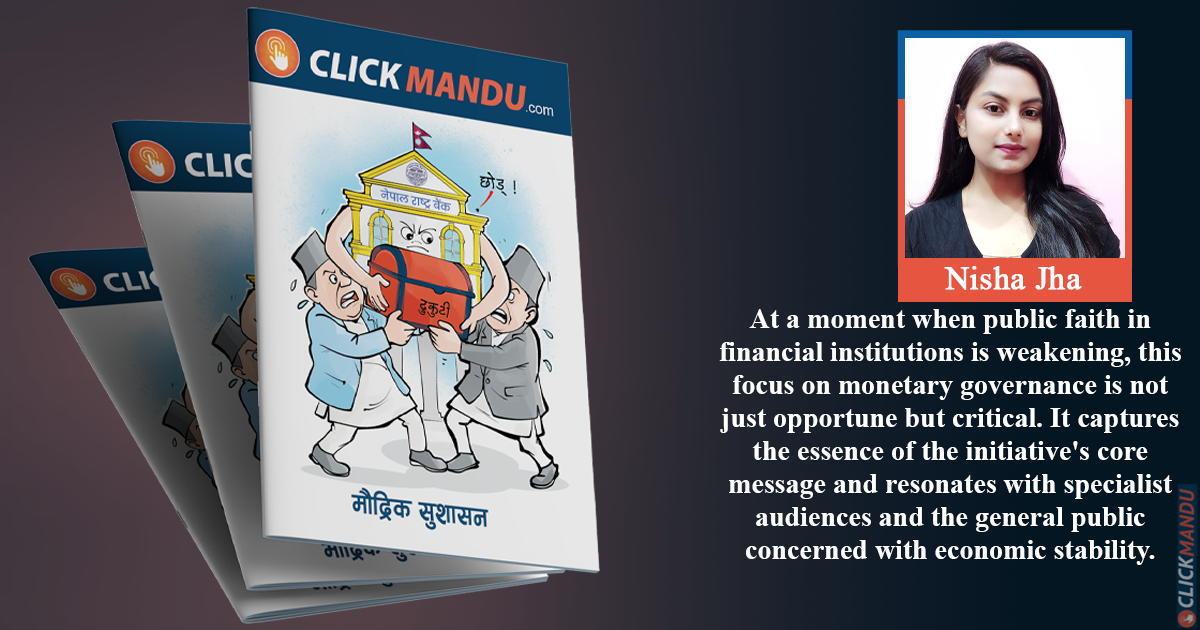Nisha Jha
Clickmandu.com’s initiative in bringing “Maudrik Sushasan”(monetary governance) to the forefront is of urgent relevance in the present economic context of Nepal. As the country struggles with spiraling inflation, volatile capital markets, and political interference at the Central Bank, the need for sound and transparent monetary governance has never been more urgent. By offering edited expert commentaries from former governors to economists and financial analysts, the magazine has opened a space for public debate on central bank autonomy, regulatory reform, and monetary strategic direction. These debates are necessary when fiscal populism too often runs into conflict with monetary prudence, blurring the lines of economic management.
The title of the magazine “Maudrik Sushasan” is appropriate and well-timed, and it directly mirrors the root problems of Nepal’s monetary system. It brings to light not just monetary policy, but the quality of governance behind its accountability, discipline, and integrity within institutions like Nepal Rastra Bank (NRB). With economic troubles deepening, the term is a call for reformation, transparency, and professionalism in monetary management.
At a moment when public faith in financial institutions is weakening, this focus on monetary governance is not just opportune but critical. It captures the essence of the initiative’s core message and resonates with specialist audiences and the general public concerned with economic stability.
The publication offers a comprehensive collection of views of experts on Nepal’s financial system, echoing the conflicting role of monetary and fiscal policy and its impact on economic stability. Policy inconsistency is pointed out by NRB Governor Dr. Bishwanath Paudel, whereas Siddharaj Bhatt is interested in the control of foreign exchange rates. Writers like Ramu Paudel and Dr. Chiranjeevi Nepal emphasize the need for improved governance of financial institutes amidst political interference. Themes range from weakening credit standards to eroded capital markets, nagging issues in the banking sector and the necessity of institutional governance.
The articles address the future of guided lending, bank reforms, and entrepreneurship development. The issue also explores the central bank’s leadership role, shadow banking, energy financing, and payment systems. Commentaries on figures like former governor of NRB Dr. Yubaraj Khatiwada and the opinions by retired bankers provide candid insights into past policies, institutional weaknesses, and forward-looking strategies.
Although the magazine performs well in bringing forth smart arguments about Nepal’s money management, it has some shortcomings in its coverage of monetary governance. One such shortcoming realtes to the lack of comparative international analyses or best practices. We cannot find sharp analysis of how other emerging economies that have similar monetary problems—such as Bangladesh, Sri Lanka, or Ghana—have strengthened their central bank independence, improved inflation targeting, or resisted political meddling. Such comparative analysis could have given policymakers and readers particular lessons and directions for reform that are relevant to Nepal.
Another limitation is the lack of rich discussion of the monetary policy transmission mechanism. Even though there are some articles calling the authorities of the NRB into question, little is mentioned about how actually the policies filter through the financial system and affect credit, consumption, and investment. Without such knowledge, the effectiveness of proposed solutions is dubious. Similarly, the magazine ignores the role of digital monetary tools or real-time payment systems, which are emerging as vital tools of monetary governance everywhere.
Furthermore, although governance and regulation have been argued over, the issue is lacking in not adequately considering data transparency and accountability frameworks in monetary institutions. In an age of open data and evidence-based policy-making, this is a significant gap.
Finally, though political interference is mentioned, too little attention is paid to how legal frameworks and institutional checks can be strengthened to guarantee long-term central bank independence.
One particular loophole that readers will point out is the absence of young voices from the debate. While the publication has incorporated experts and senior policymakers, it lacks input from freshly graduated economists or student researchers who could have advanced new ideas, especially on long-term reform needs. It would have made the initiative more inclusive and forward-looking if such voices were represented.
In order to strengthen the discourse on maudrik sushasan, future editions of the magazine must incorporate more analytical content and a wide range of issues. First, as mentioned above, incorporating comparative foreign experiences can identify measures of reform that have worked in countries with similar economic challenges. This can serve as a learning forum for monetary decision-makers and policy analysts in Nepal.
Second, greater focus is needed on the monetary policy transmission mechanism, explaining how central bank decisions affect inflation, liquidity, and real credit flows. Third, the role of digital finance instruments digital payments infrastructure, and fintech regulation should be considered in modern monetary governance and articles pertaining to it need to be included.
Furthermore, additional discussion on transparency, accountability, and data-driven policymaking will enhance institutional trust. More articles on these subjects will enrich the reading experience.
Lastly, the inclusion of youth voices, scholars, and fresh research perspectives will promote inclusive policy dialogue. This balanced, forward-thinking approach can advance public understanding and promote more responsive and effective monetary governance in Nepal.
The writer is a student of economics at Patan Multiple Campus.
Views are personal.



Comment Here